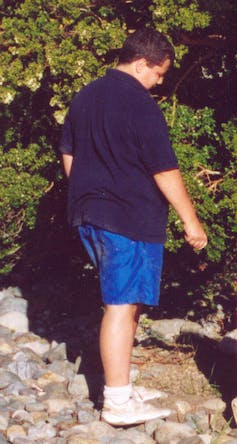Picture this common scenario: A mother is worried about the size of her 13-year-old daughter, who appears quite a bit heavier than the other students in her class. But the mother is reassured by her friend that it’s only puppy fat and her daughter will grow out of it. So no efforts are made to examine, and potentially alter, the girl’s diet or levels of physical activity.
So is “puppy fat” a true phenomenon? Do young people who are overweight during puberty usually grow out of it?
Let’s consider the evidence.
A 2010 study that monitored the weight status of 900 children in Victoria found those who were carrying excess weight in primary school were likely to still be carrying the excess weight in later high school.
The children were first seen between the ages of five and 10, and were followed up eight years later. One in five of the students were persistently overweight or obese in both mid childhood and adolescence, with some additional young people developing excess weight for the first time in their teen years.
If excess weight in adolescence wasn’t associated with any health problems, there wouldn’t be cause for concern. But adolescents who are overweight or obese are more likely to have a range of risk factors for heart disease and related problems, just as they are in adulthood.
In a NSW study of almost 500 school students aged 15 years, overweight or obese boys were more likely to have elevated blood pressure and cholesterol, abnormal levels of insulin (suggesting a form of pre-diabetes) and poor liver function, than boys whose weight was in the healthy range.
Similar findings were found among adolescent girls, although they weren’t as pronounced.

These health problems, just like excess weight in childhood, don’t just go away. Adolescents who are overweight or obese, or who have risk factors for heart disease, tend to retain these health problems into their middle age.
A recent Finnish study found teen body mass index (BMI) and disease predictors such as high blood pressure correlated strongly with their risk of obesity-related disease at age 30 to 45.
Given all this, it’s clear the popular concept of “puppy fat” as being just a transient phenomenon is a myth. And Australian children have grown increasingly overweight and obese over the past two to three decades.
What, then, should be our response?
Well, extreme measures such as mandating extra PE classes for overweight students or forcing parents to attend healthy lifestyle programs isn’t the answer. But we can’t ignore the often life-long health problems obesity brings.
Instead, we need to provide supportive environments for all young people, whatever their weight status. Within the home, we need to encourage parents to provide a healthy food and activity environment.
If a young person does have a weight problem, then this needs to be handled sensitively, with parents supporting teens, rather than forcing them, to make healthier lifestyle choices.
Parents should try not to nag adolescents about what they’re eating, as this can put the defences up. But it’s a good idea to keep tempting foods such as soft drink, chocolate, biscuits and cakes away from the house. (If they are there, they will be eaten!)
There are some great resources available to assist parents through this process but if you remain concerned about your teen’s weight, consider a medical review by a youth-friendly GP.
More broadly, all of us should be advocating for changes to the environment that make healthy choices – around what you eat and how active you are – the easy choices for everyone.
We shouldn’t be dismissive of the consequences of excess weight, and especially obesity, in young people. Instead, we need to put to death the myth of puppy fat and address the factors that promote unhealthy weight gain.

